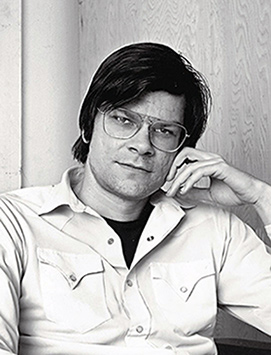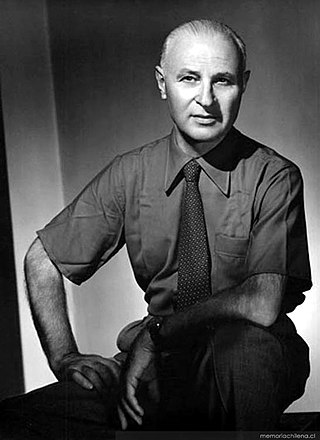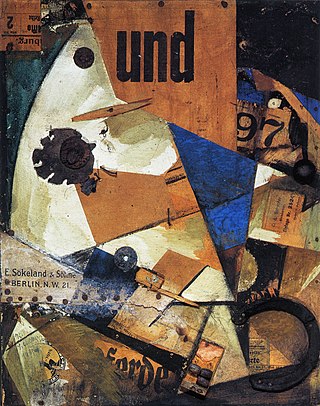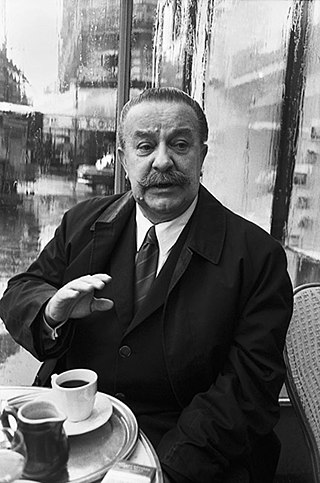
Robert Smithson was an American artist known for sculpture and land art who often used drawing and photography in relation to the spatial arts. His work has been internationally exhibited in galleries and museums and is held in public collections. He was one of the founders of the land art movement whose best known work is the Spiral Jetty (1970).

Postmodern art is a body of art movements that sought to contradict some aspects of modernism or some aspects that emerged or developed in its aftermath. In general, movements such as intermedia, installation art, conceptual art and multimedia, particularly involving video are described as postmodern.
Bruce Conner was an American artist who worked with assemblage, film, drawing, sculpture, painting, collage, and photography.

Assemblage is an artistic form or medium usually created on a defined substrate that consists of three-dimensional elements projecting out of or from the substrate. It is similar to collage, a two-dimensional medium. It is part of the visual arts and it typically uses found objects, but is not limited to these materials.

Amadeo de Souza-Cardoso was a Portuguese painter.

Lenore Tawney was an American artist working in fiber art, collage, assemblage, and drawing. She is considered to be a groundbreaking artist for the elevation of craft processes to fine art status, two communities which were previously mutually exclusive. Tawney was born and raised in an Irish-American family in Lorain, Ohio near Cleveland and later moved to Chicago to start her career. In the 1940's and 50's, she studied art at several different institutions and perfected her craft as a weaver. In 1957, she moved to New York where she maintained a highly successful career into the 1960's. In the 1970's Tawney focused increasingly on her spirituality, but continued to make work until her death.

Emilio Pettoruti (1892–1971) was an Argentine painter, who caused a scandal with his avant-garde cubist exhibition in 1924 in Buenos Aires. At the beginning of the twentieth century, Buenos Aires was a city full of artistic development. Pettoruti's career was thriving during the 1920s when "Argentina witnessed a decade of dynamic artistic activity; it was an era of euphoria, a time when the definition of modernity was developed." While Pettoruti was influenced by Cubism, Futurism, Constructivism, and Abstraction, he did not claim to paint in any of those styles in particular. Exhibiting all over Europe and Argentina, Emilio Pettoruti is remembered as one of the most influential artists in Argentina in the 20th century for his unique style and vision.

Ella Bergmann-Michel was a German abstract artist, photographer and documentary filmmaker. An early student of constructivist art in Germany, her contributions to modern abstract art are often forgotten in American art culture. Bergmann-Michel’s style was very specialized and unique, especially considering the restrictive time in which she was actively working. Most of her work is not titled or signed, making it hard to identify and find in today's art market.

Collage is a technique of art creation, primarily used in the visual arts, but in music too, by which art results from an assemblage of different forms, thus creating a new whole.

291 was an arts and literary magazine that was published from 1915 to 1916 in New York City. It was created and published by a group of four individuals: photographer/modern art promoter Alfred Stieglitz, artist Marius de Zayas, art collector/journalist/poet Agnes E. Meyer and photographer/critic/arts patron Paul Haviland. Initially intended as a way to bring attention to Stieglitz's gallery of the same name (291), it soon became a work of art in itself. The magazine published original art work, essays, poems and commentaries by Francis Picabia, John Marin, Max Jacob, Georges Ribemont-Dessaignes, de Zayas, Stieglitz and other avant-garde artists and writers of the time, and it is credited with being the publication that introduced visual poetry to the United States.

Universal War is an artist's book by Aleksei Kruchenykh published in Petrograd at the beginning of 1916. Despite being produced in an edition of 100 of which only 12 are known to survive, the book has become one of the most famous examples of Russian Futurist book production, and is considered a seminal example of avant-garde art from the beginning of the twentieth century.
Agustín Lazo Adalid was a Mexican artist and playwright who is credited with introducing surrealism to Mexico. Although he grew up during the era of the Mexican Revolution, his time in Europe in the 1920s and early 1930s, set his aesthetics towards the avant-garde movements of that continent, rather than towards Mexican muralism, making him a part of the Los Contemporáneos or “Grupo sin grupo.” His work in art and theater influenced each other, with his art having theatrical themes and his theater having emphasis on sets and visual cues. Lazo retired from art in 1950, after the death of his long-time partner poet Xavier Villaurrutia, supposedly never painting or writing again.
Avant-garde art and American pop culture have had an intriguing relationship from the time of the art form's inception in America to the current day. The art form, which began in the early half of the nineteenth century in Europe, started to rise slowly in America under the guise of Dadaism in 1915. While originally formed under a group of artists in New York City who wanted to counter pop culture with their art, music, and literature the art form began to grow into prominence with American pop culture due to a variety of factors between the 1940s to the 1970s. However, from many factors that arose in the late 1970s, avant-garde began to both lessen in prominence and began to blend with the pop culture to the point in which most art critics considered the art form extinct.

James Edward Brewton was an American painter and printmaker who synthesized expressionism, graffiti and Pataphysics.
Josip Seissel was a Croatian architect and urban planner, who under the pseudonym of Jo Klek was a constructivist artist, graphical designer and theatrical designer. A member of the influential avant-garde Zenit movement of the 1920s, he is considered to be a pioneer of surrealism and abstract art in Croatia.

Adolf Hitler, dictator of Nazi Germany from 1933 until his suicide in 1945, was also a painter. He produced hundreds of works when he tried to sell his paintings and postcards to earn a living during his Vienna years (1908–1913) but had little commercial success. A number of his paintings were recovered after the Second World War and have been sold at auctions for tens of thousands of dollars. Others were seized by the United States Army and are still in U.S. government possession.
Vlado Martek is a Croatian artist whose work is based on visualising poetry. In his art pieces he works with poems and fragments of poems by putting them into collages, photographs, plots, graphics, sketches, drawings, art actions and agitations, graffiti and wallpapers. Vlado Martek lives in Zagreb, where he works as a librarian since 1979.

Ten Dollar Bill is a 1956 proto-pop art lithographic drawing by Roy Lichtenstein. Considered to be a combination of Americana art and cubism, the work is referred to as the beginning of Lichtenstein's work on pop art. Twenty-five editions of the lithograph were made by Lichtenstein, which were exhibited at several galleries. The piece is based on the design for the ten-dollar bill and has influenced several of Lichtenstein's later works. The picture has received generally favorable reception from critics, and is considered to be one of the best artistic portrayals of currency.

Adolf Hoffmeister was a Czech writer, publicist, playwright, painter, draughtsman, scenographer, cartoonist, translator, diplomat, lawyer, university professor and traveller. During the war, editor of the radio station Voice of America, after the war ambassador in Paris, since 1951 professor at the Academy of Arts and Crafts in Prague. He was a founding member of Devětsil (1920), chairman of the Union of Czechoslovak Visual Artists, a member of International Association of Art Critics. Hoffmeister represented Czechoslovakia at UNESCO, the PEN Club and other international organizations. Hoffmeister's career was ended by the Warsaw Pact invasion of Czechoslovakia in August 1968 and the subsequent occupation.
















